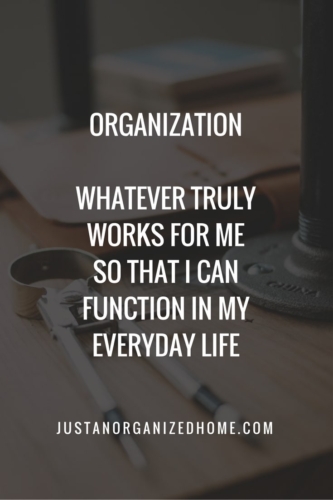What exactly is organization?
We talk a lot about “getting organized,” but what does that really mean? When I think of “being organized,” visions of sparse, minimalist homes dance in my head. Vast, clutter-free horizontal surfaces abound, not a single pile of paper is to be found anywhere, and all items are arranged in beautiful, color-coded containers.
Looking at Pinterest only adds fuel to this fantasy. Given what I see there, the beautifully organized people live in mostly-white homes with freshly-cut flowers, minimal possessions, and no children. The impossible dream!
Let’s face it, in my home there are piles of paper (and other… things), kids eat snacks in the living room, and the closest thing to a fresh flower in January is the leftover poinsettia from Christmas. So given that this level of all-white organizational perfection isn’t going to happen in my lifetime, what would organization look like in my down-to-earth reality?

A Realistic Definition of Organization
At the end of the day, organization is whatever truly works for me so that I can function in my everyday life and flourish in my creative work. It usually does not equal tidiness in the sense of everything in its place.
Ever since I recently read this book, Messy: The Power of Disorder to Transform Our Lives![]() , I’ve been mulling over the idea that organization does not equal tidiness. Could it be true? I think we are often lured in by those oh-so-perfectly organized pictures and think that order must somehow be next to awesomeness.
, I’ve been mulling over the idea that organization does not equal tidiness. Could it be true? I think we are often lured in by those oh-so-perfectly organized pictures and think that order must somehow be next to awesomeness.
But all this tidiness does not always equal effectiveness and productivity. True, a certain level of order is necessary for sanity. I can’t tell you how many times I have pawed through stacks of papers to find something. So yes, I need some way of organizing things so that I don’t lose them.
I'd like to send you something...
Download my FREE Declutter Toolkit
The Upside of Messiness
On the other hand, when I sort through the stacks over and over, I encounter things that are no longer needed, and so they get recycled. If I were extremely tidy, I probably would have filed that paper, where it would live on indefinitely in the depths of the filing cabinet. In that location, all it would do is overstuff the filing cabinet and obscure the good stuff.
Sometimes in my excavations, I come across things I have forgotten about, but I am freshly reminded that I want to do. This is not to say that putting things on lists and neatly filing them wouldn’t work—really, both systems have their merits. But perhaps we shouldn’t be too quick to dismiss the possibility that just because something looks like a mess doesn’t mean it isn’t a useful system.
The Dividing Line: Chaos vs. Order
The dividing line between functional messiness and dysfunctional chaos is what I need to explore. Chaos implies that there is no longer any organizing principle and the system has broken down. That is the point where I am just wallowing in my stuff and have no way of dealing with any of it. I’ve been there and it is no fun. It’s overwhelming and induces panic and/or depression.
But when I am very active, creative, and productive—things are not neat! However, in this state, I am not panicked or depressed; I am working and creating. Things are good. What I really need is to figure out how to keep my creative mess from descending into chaotic disaster. And I think that this is where having organizing systems maintains the line.
Last update on 2025-05-23 / Affiliate links / Images from Amazon Product Advertising API
